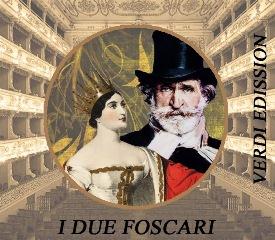Giuseppe Verdi - I due Foscari (1968)
Giuseppe Verdi - I due Foscari (1968)

1. Overture 2. Silenzio 3. Ecco la mia Venezia! 4. No... mi lasciate 5. Tacque il reo! 6. Eccomi solo alfine 7. Figlia... t'avanza... 8. Notte! Perpetua notte che qui regni! 9. Ah, sposo mio! 10. Là si ride, qui si muor 11. Ah, padre! 12. Che piu si tarda 13. O patrizi... il voleste 14. Alla gioia! 15. Donna infelice, sol per me infelice 16. Egli ora parte! 17. O nobili signori, che si chiede da me 18. Quel bronzo ferale Francesco Foscari, Doge di Venezia - Mario Zanasi Jacopo Foscari - Renato Cioni Lucrezia Contarini - Luisa Maragliano Jacopo Loredano - Franco Pugliese Barbarigo - Fernando Iacopucci Pisana - Vera Magrini Fante del Consiglio de' Dieci - Mario Carlin Servo de Doge - Giorgio Onesti Chorus - Teatro dell'Opera di Roma Orchestra - Teatro dell'Opera di Roma Bruno Bartoletti – conductor
The operas of Giuseppe Verdi fall into two sharply divided categories: popular works, such as La Traviata and Aïda, which have dominated the schedules of opera houses virtually since their composition, and those less fortunate dramas which maintain only a foothold in the repertory. Perhaps undeservedly, I due Foscari falls into the latter camp, having enjoyed only a modest success in its time and seeing only occasional modern revivals. This is certainly due, at least in part, to the "downer" effect of its plot: the son of an aged and morally upright ruler is falsely accused and put to death, and the ruler himself is eventually deposed, only to die of a broken heart. However, I due Foscari contains a great deal of attractive music and some features that are rare -- even unique -- in Verdi's creative universe; the work as a whole shines an interesting spotlight on this period of the composer's stylistic evolution.
Verdi composed I due Foscari in the latter half of 1844, directly after the premiere of his highly successful Ernani; the commission came from the Teatro Argentina in Rome. As was the case with many of his works, the subject of the libretto -- written by the ever-reliable Francesco Maria Piave -- was dictated to some extent by government censorship; in this instance, they felt the original subject, that of the powerful Medici family, to be inappropriate, and so the Foscaris were substituted in their place. Piave and Verdi collaborated for a period of four months, and the finished work was premiered at the Teatro Argentina on November 3.
The score for I due Foscari is relatively short by Verdi's standards (usually running about one and a half hours), and its scenic and chorus requirements are modest, leaving it within the reach of even smaller companies. The orchestration is fairly typical of operas of this period, but the clarinet is elevated to unusual prominence. The composer's harmonic language is richer than that employed in Ernani; likewise the orchestral strings play a much greater dramatic role. However, the most interesting feature of the score is Verdi's association of a specific theme with each of the three principal characters in the manner of a Wagnerian leitmotiv. The use of this technique was something of a false start for Verdi since he did not turn to it again until La forza del destino of 1862.
Verdi went to great lengths to infuse I due Foscari with local color. Set against such Venetian landmarks such as the Doge's Palace and the Piazza di San Marco, much of the music is influenced by the rolling meter and chromatic inflections of gondolier's songs (such as Jacopo's first-act cavatina, "Dal più remoto esilio"). At the close of the opera, we hear the bell of St. Marks' Basilica. While often attractive by themselves, these moments do not often jell convincingly with the rest of the score, and Verdi was less inclined to try such local touches in his future works.
The relationships between the main characters, and Verdi's musical responses to them, will remind some of his later, more famous, examples. Here -- between the elder Francesco, the son Jacopo, and Jacopo's wife, Lucrezia -- there are shades of both father and son Germont, Violetta (all from La traviata), King Phillip (Don Carlo), and even Otello and Desdemona (Otello). In fact, the greatest strength of I due Foscari is the degree to which the composer focused his music around these sympathetic (if still relatively undeveloped) characters, and his ability to do so within the standard formal conventions of the time. ---allmusic.com
download (mp3 @320 kbs):
yandex mediafire uloz.to mega 4shared cloudmailru








